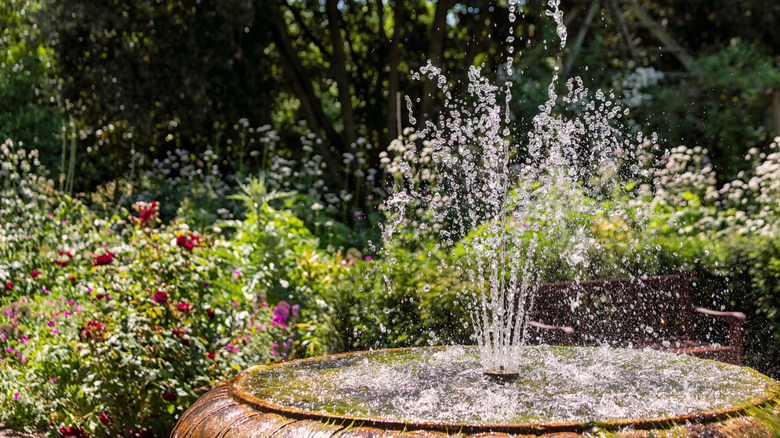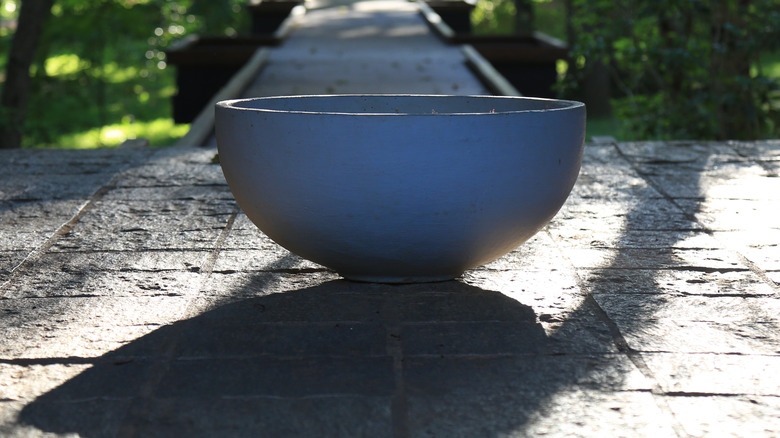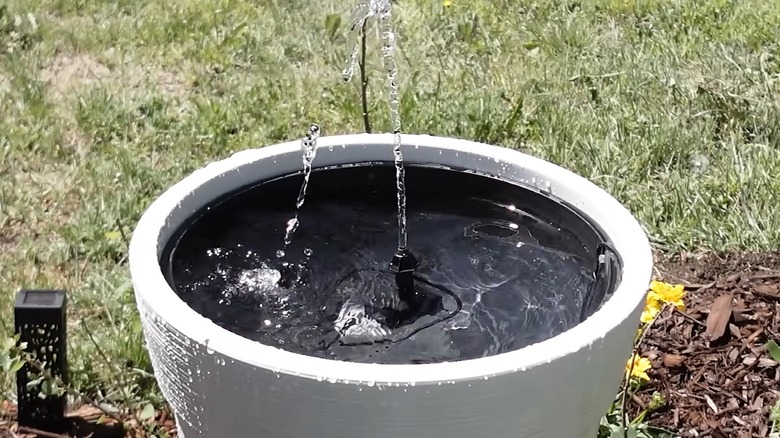How To Turn A Ceramic Bowl Into An Affordable Garden Water Feature
We may receive a commission on purchases made from links.
Gardening might be your one true love in life. However, if you're having trouble attracting birds, butterflies, and bees or want to create a Zen-like atmosphere in your backyard, you must think beyond planting flowers and trees. A small patio idea to spruce up your backyard is to add a water feature to your garden. The only drawback? Outdoor fountains tend to be quite expensive and you can expect to spend about $2,745 on average. But what if we told you that you can DIY a garden water feature for a teeny tiny fraction of the estimated cost? You just need a ceramic bowl and a solar fountain pump to set it up.
Get the bowl from your local garden center or home improvement store. Thrift stores are also a great place if you're on a tight budget. You can even repurpose one you have at home. Regarding the fountain pump, try out standalone models like DDcafor's 1.5W Mini Solar Powered Water Pump. Alternatively, consider AMIAEDU's 4W Pump with LED Lights for a colorful garden display once the sun sets. Either way, keep in mind that your water feature will only spray water if it receives ample sunlight. Cloudy weather or weak sunlight will reduce its efficiency, with the feature not working at all on particularly dark and dreary days. You must also keep the panels clean and the pump area free of debris. So, although the fountain is an affordable way to add a water feature to your garden, be prepared to clean and maintain it regularly.
Scope out the location and finalize how you want to display your garden's water feature
As mentioned above, direct sunlight is necessary for your solar water pump to work efficiently. Placing it beneath trees that cast shade or under other patio features will ruin your plans. So, pick an ideal spot for your water feature in the garden. In case space is premium or you'd like to place the fountain on your deck, opt for a separate solar panel and pump. Biling's Fountain Pump Kit with Stake is a good option. This way, you can insert the panel into the soil where it'll receive optimal sunlight and put up the feature in a separate location. That being said, measure the cord before finalizing the location for the panel or the pump.
Once you finalize the location, determine how you'll display your DIY water feature. Will you just place the ceramic bowl on a ledge or cobbled stones nearby? Or, do you want to add a little pizzazz to your project? If you pick the first option, you're all set. But if you go the decorative route, you'll need to pick an ornamental base for your bowl. For instance, nestling your small bowl within a larger one and surrounding it with flowers will brighten up your dull patio with minimal effort. You'll need a large planter, some potting soil, good quality artificial flowers so they look real, and a few bricks or an old bucket to achieve this DIY. You could even set the bowl within a rustic chair you thrifted recently. Your old birdbath works, too, provided it's large enough to house the bowl.
How to DIY an affordable garden water feature
For a simple garden water feature, simply grab your ceramic bowl and place the solar fountain pump inside. Add a little water inside (refer to the manufacturer's instructions to avoid going over- or remaining underboard) and wait for the pump to absorb enough sunlight to start working. Play around with the water spray configurations until you find something you like, and you'll be done. If you use a ceramic planter instead, ensure you plug all holes with Gorilla's Waterproof Caulk and Silicone Sealant before you pour water inside. In case you don't like its basic appearance, paint the bowl to match your outdoor space. Or, add decorative pebbles inside it. Sprinkle in floating pond plants that are hardy to your area for a gorgeous pond-like effect. Avoid going overboard, or the pump might get clogged and stop working.
Want to turn the water feature into your garden's focal point? Get a large planter and add leftover bricks ⅔ of the way. You could even place a five gallon bucket or another planter inside. This will serve as your ceramic bowl's sturdy base. Fill the gaps with potting soil (keeping the bricks clean) and place your bowl on top. Now, tuck in artificial flowers (or real ones if you don't mind taking care of them) around the bowl's rim and add the pump as outlined above. Substitute the flowers with gravel stones for a clean look and low-maintenance DIY. Whichever way you go, don't forget to use something like API Store's AlgaeFix to prevent algae from creeping in your fountain and muddying the base.


